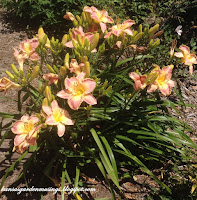 My, my, how time flies by and leaves us standing in the dust of our best intentions. I was on track for several months to add bi-weekly notes to this blog, but in the middle of June my resolve ran up against the Kansas climate and melted like butter on a stove. This toadstool photo, taken this morning, is illustrative of our gardening year here.
My, my, how time flies by and leaves us standing in the dust of our best intentions. I was on track for several months to add bi-weekly notes to this blog, but in the middle of June my resolve ran up against the Kansas climate and melted like butter on a stove. This toadstool photo, taken this morning, is illustrative of our gardening year here.You see, friends, I came into this gardening year so excited for new life and new growth. Ample rains in March and April erased our long drought and opened up all the nascent promise of
my garden, a green and growing paradise in my immediate vision. It was almost perfect right up until we received the hailstorm in the last week of April, a hail that stripped leaf and promise and future.
May was quiet here, quiet except for the few peony buds and roses that survived the hail. There were few irises, peonies, and roses in my early garden, and as the season developed, it was apparent that there were to be no strawberries, cherries, peaches, or apples to console my feelings. I struggled even to enter my garden, pained by the lack of bloom and vigor, but I held out hope for my stalwart daylilies.
And then, in late May and through June, the heat struck and the rain stopped. The garden dried and the ground cracked. The grass turned brown and even the daylilies slowed their onslaught. Hemerocallis is a tough genus, but not tough enough for early drought. They bloomed, but not in their usual numbers or robust cheerfulness.
In late June and early July, it rained again, and kept raining at regular intervals, a unusual pattern for Kansas, and the grass greened up and the weeds rushed in. Weeds, weeds everywhere, but not a domesticated flower to be seen. Normally, in July, I can count on mowing every other week and relaxing from the heat. Not this year, for I have been forced into weekly mowings of the entire yard and weeding at every opportunity. Roundup is my new best friend. And the ground is wet, wet enough so that toadstools grow in July right by the front walk. You can guess that the tomatoes in this area are not performing very well in the wet clay. Right now, the only crops that look to be decent are watermelons and cantaloupes.
And so I stand, on the brink of August, too busy with other things to garden, too depressed to even look at my devastated strawberry bed, too chagrined to even hope for a colorful fall. I'll write when I can. I've saved a few photos of the best of the year. Maybe I can summon the cheerfulness in August to highlight them.
Until then, adieu.




























.jpg)
.jpg)



.jpg)
.jpg)
.jpg)
.jpg)



.jpg)
.jpg)







